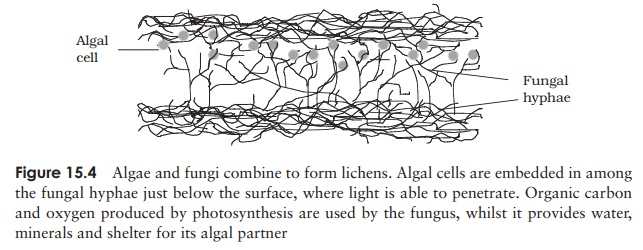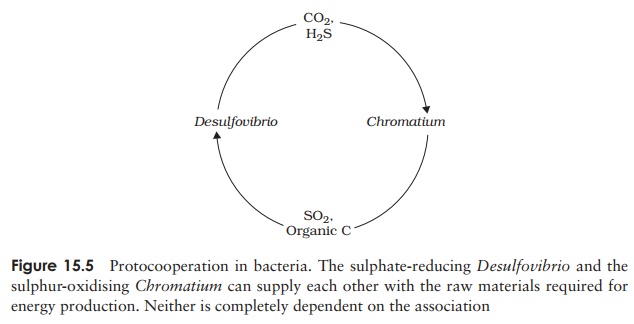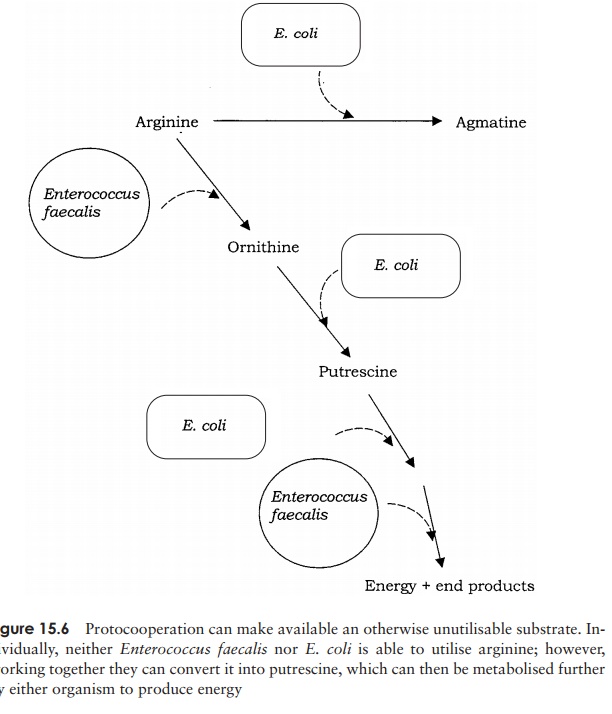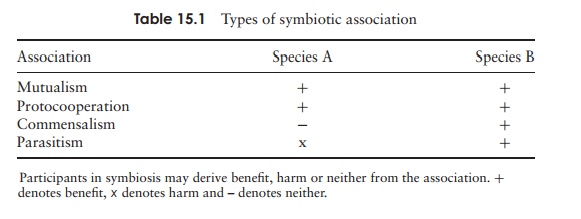Chapter: Essential Microbiology: Antimicrobial Agents
Microbial associations with other microorganisms
Microbial
associations with other microorganisms
The most familiar example of mutualism between
microorganisms is that of lichens,
which comprise a close association between the cells of a fungus (usually
be-longing to the Ascomycota) and a photosynthetic alga or cyanobacterium.
Although many different fungal species may take part in lichens, only a limited
number of algae or cyanobacteria do so. Lichens are typically found onexposed
hard surfaces such as rocks, tree bark and roofs, and grow very slowly at a
rate of a millimetre or two per year. They often occupy particularly harsh
environments, from the polar regions to the hottest deserts. The photosynthetic
partner usually exists as a layer of cells scattered among fungal hyphae (Figure
15.4). Often unicellular, it fixes carbon dioxide as organic matter, which the
heterotrophic fungus absorbs and utilises. The fungal member provides anchorage
and supplies inorganic nutrients and water, as well as protecting the alga from
excessive exposure to sunlight.

Although lichens are tolerant of extremes of temperature and water loss, they have a well-known sensitivity to atmospheric pollutants such as the oxides of nitrogen and sulphur. Their presence in an urban setting is therefore a useful indicator of air quality. Lichens were used for many years as a source of brightly coloured dyes for the textile industry; they are also used in the perfume industry. The dye used in litmus paper is derived from a lichen, belonging to the genus Roccella.
It should be stressed that lichens are not just a
mixture of fungal and algal cells. They are distinctive structures with
properties not possessed by either of their component species. Indeed, the
relationship between the two partners of a lichen is so intimate that the
composite organisms are given taxonomic status. Many thousands of species of
lichen have been identified.
As noted in the definitions, a mutualistic
relationship need not always be as intimate and essential to both partners as it
is in a lichen. The sulphate-reducing bacteria Desulfovibrio, for example, can obtain the sulphate and organic
substrates it needs from the photosynthetic purple sulphur bacterium Chro-matium, which in turn receives the
carbon dioxide and hydrogen sulphide it requires(Figure 15.5). This
protocooperation is not essential to either bacterium, however, as each can
satisfy its requirements by alternative means. In another bacterial
relationship,

the gut bacteria E.
coli and Enterococcus faecalis cooperate
to utilise arginine. As shown by Figure 15.6, neither can usefully metabolise
this amino acid on its own; however, neither is dependent on the reaction.

Commensal relationships, in which one partner
benefits and neither suffer, are com-mon among microorganisms; such
associations are rarely obligatory. A common basis for microbial commensalism
is for one partner to benefit as a coincidental consequence of the normal
metabolic activities of the other. Thus, one may excrete vitamins or amino
acids that can be utilised by the other, or a facultative anaerobe may assist
its obligate anaerobe neighbour by removing oxygen from the atmosphere, thus
providing the con-ditions for the latter to grow.
The nature of a role played by an organism in a
symbiotic relationship may alter according to the prevailing conditions. In a
soil already rich in nitrogen, for example, the legume derives no benefit from
the Rhizobium, which is then more
accurately classed as a parasite, as it continues to utilise organic carbon
produced by the plant. In humans, harmless gut symbionts such as E.
coli can become opportunistic pathogens, and cause
infections if intro-duced to an inappropriate site such as a wound or the
urinary tract.
A limited number of microorganisms exist by living
parasitically inside another. Viruses
are all obligate endoparasites that form an association with a specific
host. This host may be microbial: bacteria, fungi, protozoans and algae all act
as hosts to their own viruses. Viruses of bacteria are termed bacterio-phages and are only able to
replicate themselves inside anactively metabolising bacterial cell. An unusual
bacterium belonging to the genus Bdellovibrio
also parasitises bac-teria, but as it does not properly enter the cell, is more
properly thought of as an ectoparasite or even a predator. Other non-viral
parasitism involves bacteria or fungi on protozoans, and fungi on algae and on
other fungi.

Related Topics